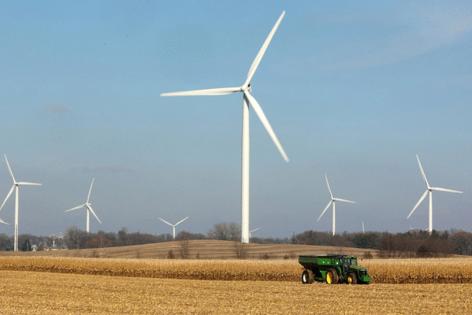Clean energy developer suspends wind project in Minnesota, cites tariffs as a factor
Published in Business News
A clean energy developer is temporarily halting its proposed wind farm in southwest Minnesota, saying the Trump administration’s tariffs are partly to blame.
The decision has alarmed some clean energy advocates, who say President Donald Trump’s ongoing trade war is making the already difficult process of connecting renewable energy projects to the electrical grid even harder.
National Grid Renewables’ Plum Creek Wind project had already cleared some of the most common hurdles for a clean energy project. State regulators approved two key permits for the project, which includes 230 megawatts of wind generation, back in 2021. Construction was set to begin later this fall.
The project would place up to 77 turbines on what’s now farmland in Redwood, Murray, and Cottonwood counties. The company was also proposing to add 150 megawatts of battery storage.
But last month, National Grid Renewables informed regulators it was pulling out of a monthslong bidding process, despite having reached a tentative agreement with Xcel Energy to buy the wind farm’s electricity.
In an April 25 letter to the Minnesota Public Utilities Commission, National Grid Renewables cited cost disagreements and interconnection delays in addition to tariffs.
“Recent reciprocal tariffs from the Trump administration have introduced many new risks to supply chains across the economy,” the company’s attorney wrote in the letter. “This is contributing to rapid and significant cost uncertainty, delays and tightening bottlenecks around hardware critical to project development.”
The company said it still plans to complete the project, but its timeline is now uncertain.
National Grid Renewables spokesperson Betsy Engelking said the tariffs weren’t the top consideration in the company’s decision to pause the project. It’s already seen several delays in the studies required to connect it to the Midwest’s regional grid, run by the Midcontinent Independent System Operator (MISO). But the trade war has exacerbated the situation, she said.
“We found the cost of steel going up. Equipment prices have gone up,” Engelking said. “Particularly those are components that might come out of China.”
Plum Creek Wind’s delay now adds to a growing list of renewable energy projects nationwide that have experienced a major setback, including cancellations, since Trump took office in January. Roughly $8 billion in clean-energy-related investments, as well as 16 new large-scale factories, have been canceled, closed or downsized so far this year, according to a report from the clean energy think tank E2.
“What we are currently seeing is projects pull out,” Amanda Rome, executive vice president for Xcel Energy, recently told Minnesota regulators. Developers might bid a project to Xcel at a certain price but “see so much risk” that they later jump ship, Rome said.
The tariffs have been especially hard on the clean energy industry, which relies largely on China for key components and materials like solar panels or lithium for batteries. On Monday, Trump announced the United States would temporarily lower its tariffs on China from 145% to 30% to open up negotiations between the countries. In turn, China agreed to lower its tariffs on the U.S. from 125% to 10%.
But tariffs are far from the only obstacles clean energy projects face in the U.S. The Trump administration has blocked all wind development on federal lands and waters, as well as frozen tens of billions of dollars in clean energy and climate-related grants and loans established under the Inflation Reduction Act. Republicans in Congress have also introduced budget proposals that would slash billions of dollars of tax incentives from that law aimed at spurring investments in clean energy technologies.
Clean energy developers have also long complained about the permitting process for projects, which often takes years and sometimes decades. On top of that, the nation’s energy grids are outdated. The situation has led to a backlog of thousands of clean energy projects across the nation as regional grid operators work to upgrade their infrastructure.
When added all together, the challenges have brought many developers to “a breaking point,” said Beth Soholt, executive director of the Clean Grid Alliance, a trade association that represents clean energy developers.
“There are ups and downs that a developer has to be able to handle, and they do, but we’re making it really hard for them these days,” Soholt said. “In National Grid’s case, it’s obvious that the tariff was a contributing factor, because it kind of tipped them over the edge.”
States like Minnesota have passed laws to streamline the permitting process for clean energy projects. But those reforms alone have yet to do the trick.
Projects totaling nearly 300 gigawatts — roughly the average amount of energy produced by 300 nuclear power plants — are currently seeking connection to the MISO grid, which serves Minnesota and several other Midwest states. Of that 300 gigawatts, more than 50 gigawatts are delayed “due to supply chain issues, siting or other regulatory concerns,” said Brandon Morris, a MISO spokesperson.
The sheer number of projects vying to connect to MISO may help to explain why Plum Creek Wind spent nearly two years navigating the interconnection process. Part of that is due to growing energy demand as more people buy electric vehicles and electrify their homes.
Engelking said lengthy wait times, especially with regard to the studies that determine prices for grid upgrades passed along to developers, are among the biggest obstacles for clean energy projects today.
MISO recently received federal approval for new long-range transmission lines, which once completed, should add more capacity and allow for more projects to connect to the grid. In the meantime, project developers should anticipate more delays.
“Somebody, when I started in this business, told me that a wind project will die a thousand deaths before you actually get it built,” Engelking said. “And that’s very true when you look at all of the different kinds of approvals that you need to get.”
©2025 The Minnesota Star Tribune. Visit at startribune.com. Distributed by Tribune Content Agency, LLC.












Comments